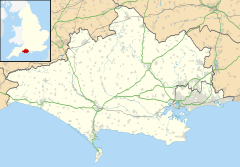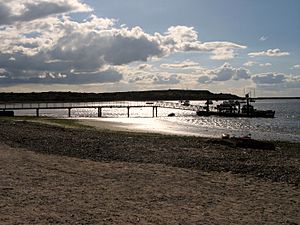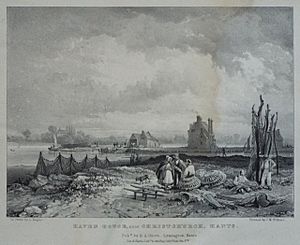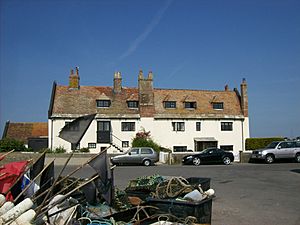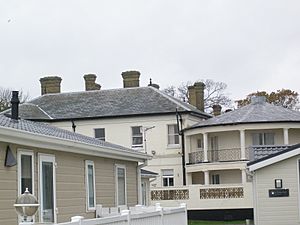Mudeford facts for kids
Quick facts for kids Mudeford |
|
|---|---|
| Population | 4,977 (2011, Mudeford and Friars Cliffe Ward) |
| OS grid reference | SZ178914 |
| Unitary authority |
|
| Ceremonial county | |
| Region | |
| Country | England |
| Sovereign state | United Kingdom |
| Post town | CHRISTCHURCH |
| Postcode district | BH23 |
| Dialling code | 01202 or 01425 |
| Police | Dorset |
| Fire | Dorset |
| Ambulance | South Western |
| EU Parliament | South West England |
| UK Parliament |
|
Mudeford is a lovely place by the sea in Christchurch, Dorset, England. It used to be a small fishing village. Mudeford is special because it has water on two sides: Christchurch Harbour and the sandy Avon Beach.
Two small rivers, the River Mude and Bure Brook, flow into the harbour here. Mudeford has grown over the years with new homes. In 2011, the wider area, including Mudeford, had over 54,000 people living there. Mudeford is a popular spot for tourists and fun activities.
The area also has two pretty woodlands, Mudeford Woods and Peregrine Woods. There's a recreation ground near Stanpit where cricket has been played for a very long time. You can also find All Saints' Church here, which was built in 1869.
Contents
Things to Do in Mudeford
Schools in Mudeford
Mudeford has its own Infants School and Junior School, named after the village itself.
Mudeford Quay
The Mudeford Quay you see today was built in the late 1940s. Before that, the area, known as the Haven, had sloping beaches. The "Run" (the entrance to the harbour) was much wider. Because of erosion, the local council bought the land in 1945. Five years later, it was built up and made stronger with steel and concrete.
Today, the Quay is still used by local fishing boats. It's also a great place for water sports. You'll find the Haven Inn pub and some old fishermen's cottages here. The Royal National Lifeboat Institution (RNLI) has a lifeboat station on the Quay, ready to help people in trouble at sea.
The Mudeford ferry takes people between the Quay and Mudeford Sandbank on Hengistbury Head. Before the 1960s, rowing boats were used for the ferry, and you paid what you thought was fair! Even George III visited Mudeford in 1801 and used a special bathing machine here.
Avon Beach
Avon Beach is about three-quarters of a mile of sand. It has gentle cliffs and is easy to get to with paths and car parks. You'll find small shops selling art and souvenirs, ice cream, and restaurants. From the beach, you can see The Needles and the western part of the Isle of Wight.
Avon Beach is one of the few sandy beaches on England's south coast. You can walk about 9 miles along the beach. After the sandy part, it becomes more shingly and pebbly, stretching all the way past Hurst Castle.
All Saints Church
The village church is All Saints Church. It was built between 1869 and 1871. It had three beautiful stained glass windows added over the years. Sadly, the church had a fire in July 2022, which caused a lot of damage. The church community hopes to rebuild it by 2026.
Historic Buildings in Mudeford
Haven House and the Dutch Cottages
The oldest buildings on Mudeford Quay are now called the Dutch Cottages. They were once known as Haven House and were built around 1687. They stand on land that was created by filling in the old harbour mouth.
One of these buildings was an alehouse (a type of pub) as early as 1699. It also provided a place for soldiers to stay. This was the first Haven House Inn. The current Haven Inn pub nearby was built around 1830.
Mudeford was well known for smuggling (illegal trading) from the 1680s. Officers were stationed here to stop it. In 1784, the Inn was central to the Battle of Mudeford. This was a big fight between smugglers and naval officers. During this time, Mudeford became a popular seaside place for wealthy people.
Later, the Haven House was used by the Coastguard service to house officers and their families. In 1861, a new Coastguard Station was built elsewhere. The Haven House then became fishermen’s cottages and is now private homes. It is a Grade II listed building, meaning it's protected for its history.
Sandhills House
Sandhills was the holiday home of George Rose, an important Member of Parliament and a friend of Prime Minister William Pitt. He had it built around 1785. Rose's friend, King George III, stayed there many times. This helped make Christchurch a popular place for tourists.
Sandhills was also home to George Rose's two sons: Sir George Henry Rose, who was a politician, and William Stewart Rose, a poet. Field Marshal Hugh Rose, George Henry Rose's son, also lived there.
Today, Sandhills is a holiday park with caravans. The original house is still there but has been turned into flats. In the 1940s and 1950s, Sandhills was even used as a school.
Gundimore House
Gundimore is a unique, listed house near Avon Beach. It was built in 1796 for the poet William Stewart Rose, the second son of George Rose from Sandhills. The name "Gundimore" is a bit of a mystery.
Famous poets like Coleridge, Southey, and Sir Walter Scott (who wrote Marmion) visited Gundimore. It's said to have been built to look like a Turkish tent, with Arabic writing, to remind the owner of his travels in the East. The house has a main section with a curved window area and a small tower.
The Anchorage House
This house, originally called Elmhurst, was built around 1870 by Viscount Bury. He bought the land to build a seaside holiday home. The building was designed by Colonel Sir Robert William Edis, a famous architect who designed many hotels in London.
In 1868, Viscount Bury was on the beach near his new home when he saw a fishing boat in trouble. With help from a Coastguardsman, he rowed out and saved one of the three fishermen. This was a very brave act!
In 1889, George Hamilton Fletcher bought Elmhurst and renamed it The Anchorage. He loved sailing. Later, in 1929, the building became a retirement and convalescent home for teachers. During World War II, it was used by the government for soldiers. After the war, it went back to being a convalescent home. It is also a Grade II listed building.
Bure Homage House
On the edge of Mudeford village was a large mansion called Bure Homage House. It was built in the early 1800s. In 1837, it was sold to Sophie Dawes, a well-known smuggler who became a French Baroness.
During World War II, it was used as an officers' mess for a fighter group. It was later used for research. Sadly, it was knocked down in 1957. The land is now used for homes.
Other Historic Buildings Still Standing
- Mudeford House (now the Christchurch Harbour Hotel) is a Grade II Listed building.
- Waterford Lodge (once the Waterford Lodge Hotel).
- Sandford Hotel (now The Moorings). This hotel also served as the Mudeford post office in Victorian times. It opened in 1835 and is a Grade II* Listed building.
- An early Victorian pillar box (post box) from 1856 is still in use near The Moorings. It is a Grade II Listed building.
- The Nelson Tavern is another historic pub in the area.
Mudeford's Lifeboats
Mudeford has a long history of saving lives at sea. The first Christchurch lifeboat was in service by 1804. It was one of the first purpose-built rescue boats in Great Britain! George Rose, who owned Sandhills, helped get this boat for Christchurch. The boat had a crew of ten rowers and a steersman, all volunteers from the local area.
In 1868, another lifeboat was given to Mudeford. This boat was designed by a famous shipbuilding firm. It was named Lord Bury because Viscount Bury and a Coastguard Boatman had bravely tried to rescue three fishermen. They saved one man and received silver medals from the RNLI and Royal Humane Society for their courage.
The first modern RNLI lifeboat, an inflatable D class boat, arrived at Mudeford Quay in 1963. The current Lifeboat Station opened in 2003.
Christchurch Airfield History
Christchurch Airfield, which was known as RAF Christchurch during World War II, was located near Mudeford Lane. By the 1960s, most of it was wild land. Today, much of this area has been replaced by homes and a school.
Famous People from Mudeford
- The Right Hon George Rose (1744–1818) was a Member of Parliament and a close friend of Prime Minister William Pitt. He built his seaside home, 'Sandhills', in Mudeford around 1785. His friend King George III often stayed there, which helped make Christchurch a popular place for visitors.
- George Rose's two sons also lived at Sandhills: Sir George Henry Rose (1771–1855), a politician, and William Rose (1775–1843), a poet.
- Field Marshal Hugh Rose (1801–1885), George Henry Rose's son, also spent time at the family home.
- Cricketer Leo Harrison was born (1922) and died (2016) in Mudeford.
Nearby Areas
Stanpit Village
Stanpit village is a historic area that borders Mudeford. The Stanpit road connects to Purewell Cross. Part of the area is home to Stanpit Marsh, a beautiful nature reserve. Stanpit is mentioned in the Domesday Book from 1086, meaning "two estates with meadows."
Somerford District
Somerford is another historic area of Christchurch that borders Mudeford. It's named after a ford (a shallow crossing) over the River Mude that could only be crossed in summer. The current Somerford Roundabout is near where this ford used to be.
Mudeford Spit
Mudeford Spit is a long strip of sand and shingle that almost closes off Christchurch Harbour. It's formed by sand and pebbles carried by the sea. The Spit is always changing shape. Before a long groyne (a wall built into the sea) was built in 1938, it often stretched towards Steamer Point and Highcliffe Castle.
The Spit has been broken through by the sea many times naturally. After the last break in 1935, the end of the Spit drifted away and formed a lagoon near Friars Cliff. The groyne built in 1938 stopped new material from reaching the Spit, causing it to erode. Many efforts have been made to protect it since then, including seawalls and rubble groynes.
Beach huts on Mudeford Spit can be reached by walking, by a land train (sometimes called the ‘Noddy’ train), or by ferry from Mudeford Quay. On the Spit, you'll see the "Black House," a local landmark. It was built in 1848 for a mining company manager, even though local legends link it to smuggling.


